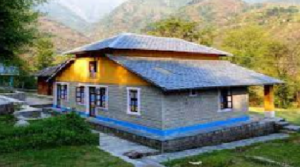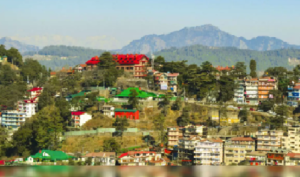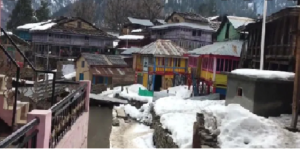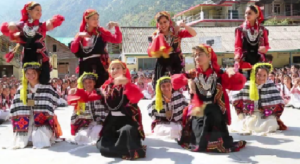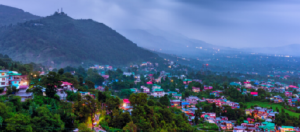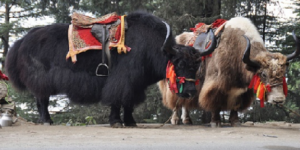Himachal Pradesh
Architecture & History
- In Himachal Pradesh, homes are made with planks of Deodar wood and filling intermediate gaps with stone. Himachali traditional house usually have Sloped roofs made of stone shingles which prevent strong hilly winds from blowing away their light roofing.
- The architecture of Himachal Pradesh is influenced by the climatic conditions and locally available material.
- The use of stone rammed earth, mud, bricks, and wood is done in accordance with the local construction techniques that help provide structural stability in the earthquake-prone state.
- The walls are thick made with sun dried bricks and plastered with mud phuska to protect from erosion due to rains. Timber beams are used while laying floor slab that pay off as beams lay over mud walls.
- The houses have double-skinned walls with the air gap between two parallel wooden beams filled with loose, with small stone pieces insulating the structure. The building technique keeps the house warm in cold weather and cool in summers. The air gaps prevents cracks and caving on the walls saving the house from earthquake.
- Manali receives very heavy rainfall and snowfall. The houses are made up of wood. The houses in the hilly areas have sloping roofs to drift away the snowfall.
- Forts, palaces, temples and monasteries are found all over the state of Himachal with numerous fine wall-paintings and statues that are valued as World Heritage Site by UNESCO.
Demographic Location
- An North Indian state situated in the Western Himalayas, Himachal Pradesh is one of the eleven mountain states and is has a charismatic landscape with several lofty peaks and incredible river systems.
- The people of Himachal Pradesh often call their home as 'Dev Bhoomi' or 'Land of Gods and Goddess'.
- The Kols or Mundas are the original migrants to the hills of Himachal Pradesh. Some other migrants were Mongoloid people known as Bhotas and Kiratas.
- Himachal is a mountainous state mostly on the foothills of Dhauladhar Range. Shilla Peak is the highest mountain peak in the state of Himachal Pradesh.
- The water system of Himachal isa mix of rivers and glaciers. Water to famous Ganges and Indus basin comes from source that originate from Himachal Pradesh.
- The river systems are the:
- Chandra Bhaga or the Chenab
- The Ravi
- The Beas
- The Sutlej
- The Yamuna
- These rivers come out by melting of snow and rainfall. They are protected by cover of natural vegetation.
- The highest peak is Reo Purgyil is in Kinnaur.
- Hot springs are found in abundance in scattered places like tattapani, Manikaran and Vashist.
- Himachal Pradesh has the largest glacier in Asia. Shigri Glacier is located in the Lahaul – Spiti area and feeds the Chenab River.
- Himachal is famous for many outdoor activities such as Rock Climbing, Mountain Biking, Ice-Skating, Trekking, Rafting,and Helo-Skiing.
- The British developed hill stations during their reign one of them being Shimla which they named as "The Summer Capital of India".
- Shimla is the state capital, a hot spot for tourist destiny.
People, Rituals and Language
- The people of Himachal Pradesh speak in Hindi. Some speak different language depending on the region they belong like Kinnauri, Lahauli, Bilaspuri and Kangri.
- The most popular local language of Himachal Pradesh is Pahari. Punjabi, Dogri, Kangri and Kinnauri language is also used in Himachal Pradesh.
- The local language in Manali is part of the group of languages known as Western Pahari.
- A Hindi dialect, which is derived from Sanskrit and Prakrit, Pahari has a number of local variations. The version spoken in Manali is known as Mandiali.
Season and Climate
- The climate varies from hot and sub humid tropical in the southern tracts to, with more elevation, cold, alpine, and glacial in the northern and eastern mountain ranges.
- Himachal experiences three seasons: summer, winter, and rainy season. Snowfall is common in alpine tracts.
- Shimla features a subtropical highland climate (Cwb) under the Köppen climate classification. The climate in Shimla is predominantly cool during winters and moderately warm during summer. Temperatures typically range from −4 °C (25 °F) to 31 °C (88 °F) over the course of a year.
Culture & Education
- There are a variety of festivals celebrated by the locals of Himachal Pradesh who worship gods and goddesses.
- There are over 2000 villages in Himachal Pradesh which celebrate festivals such as Kullu Dussehra, Chamba's Minjar, Renuka ji Fair, Lohri, Halda, Phagli, Lossar and Mandi Shivratri.
- There approximately 6000 temples in Himachal Pradesh with a known one being Bijli Mahadev.
- Major visitors sites in Himachal Pradesh are Shimla, Palampur, Chail - Kufri, Narkanda, Manali, Kullu, Kinnaur, Sangla, Reckong Peo, Dalhousie, Kangra, Mandi, Spiti valley, Mc Leodganj, Dharamshala, Parvati
- Himachal Pradesh is spread across valleys with many rivers flowing through them. In rural areas. agriculture, horticulture, hydropower and tourism are important constituents of the state's economy.
- The Hindu communities residing in Himachal include the Brahmins, Kayasthas, Rajputs, Sunars, Kannets, Rathis and Kolis.
- The tribal population of the state consists mainly of Gaddis, Gujjars, Kanauras, Bhots, Swanglas and Lahaulas.
- Himachal is well known for its handicrafts. The carpets, leather works, Kullu shawls, Kangra paintings, Chamba rumals, stoles, embroidered grass footwear, silver jewellery, metal ware, knitted woolen socks, Pattoo, basketry of cane and bamboo woodwork are among the notable ones.
- Himachali caps of various colour bands are also well-known local art work, and are often treated as a symbol of the Himachali identity.
- Local music and dance also reflects the cultural identity of the state. Through their dance and music, the Himachali people entreat their gods during local festivals and other special occasions.
- The Kullu Dussehra festival is famous all over the country. The day-to-day cuisine of Himachalis is similar to the rest of northern India with Punjabi and Tibetan influences.
- Lentils (Dāl), Rice (Chāwal or Bhāț), Vegetables (Sabzī) and chapati (wheat flatbread) form the staple food of the local population.
- Non-vegetarian food is more preferred and accepted in Himachal Pradesh than elsewhere in India, partly due to the scarcity of fresh vegetables on the hilly terrain of the state.
- Himachali specialities include Siddu, Babru, Khatta, Mhanee, Channa Madra, Patrode, Mah Ki Dal, Chamba-Style Fried Fish, Kullu Trout, Chha Gosht, Pahadi Chicken, Sepu Badi, Auriya Kaddu, Aloo
- Palda, Pateer, Makki Ki Roti and Sarson Ka Saag, Chouk, Bhagjery and Chutney of Til.
Famous Spots
- The Kalka - Shimla Railway is a mountain railway which is a UNESCO World Heritage Site.
- Other popular hill stations include Manali, Kinnuar, Kasol, Parvati Valley, Chamba, Kullu, Kinnar Kailesh, and Kasauli.
- Dharamshala, the winter capital of the state is the home of the Dalai Lama, is known for its Tibetan monasteries and Buddhist temples. Many trekking expeditions also begin from this place.
- The Ridge road is a large road in Shimla which is the centre of most cultural activities of Shimla.
- The Manali – Leh National Highway is famed for being the highest motor able road in the world.
Aqualife, Flora & Fauna
- The Great Himalayan National Park is found in the Kullu districts of Himachal Pradesh.
- There are various forest types found here such as Deodar, Silver Fir, Spruce, Oak and Alpine pastures.
- In the Great Himalayan National Park, there are a variety of animals found such as Snow Leopard, Himalayan Yak, Himalayan Black Bear, Western Trapogan, Monal and Musk Deer.
- There are sanctuaries which are tourist spots such as Naina Devi Sanctuary in Bilaspur district and Gobind Sagar Sanctuary.
- The state animal is the Snow leopard which is rare animal to spot.
- There are animals such as Indian Porcupine and giant flying squirrel found here.
- The Gobind Sagar Lake has fish species such as Mrigal, Silver carp, Katla, Mahaseer and Rohu are found here.
- Narkanda located in at an altitude of around 8850 feet is known for its apple orchards. It is located between the river valleys of Giri and Sutlej.
- Vegetation in the state is dictated by elevation and precipitation.
- The state is endowed with a high diversity of medicinal and aromatic plants. Lahaul-Spiti region of the state, being a cold desert, supports unique plants of medicinal value.
- Himachal is also said to be the fruit bowl of the country, with orchards being widespread. Meadows and pastures are also seen clinging to steep slopes.
- After the winter season, the hillsides and orchards bloom with wild flowers, while gladiolas, carnations, marigold, roses, tulips and lilies are carefully cultivated.
- Himachal Pradesh has around 463 bird, 77 mammalian, 44 reptile and 80 fish species. Great Himalayan National Park and Pin Valley National Park are the national parks located in the state.
- The state has 30 wildlife sanctuaries and 3 conservation reserves. The state bird of Himachal Pradesh is the Western tragopan.

